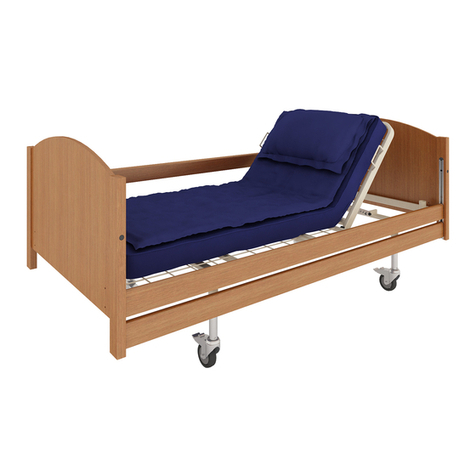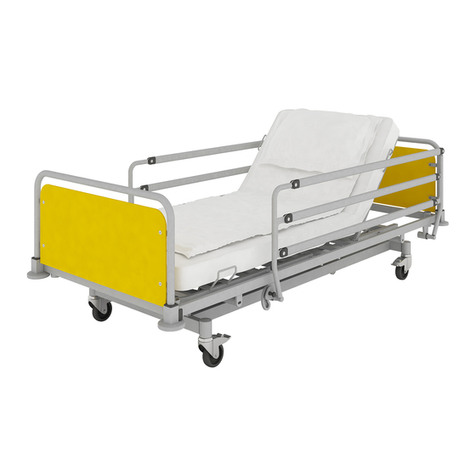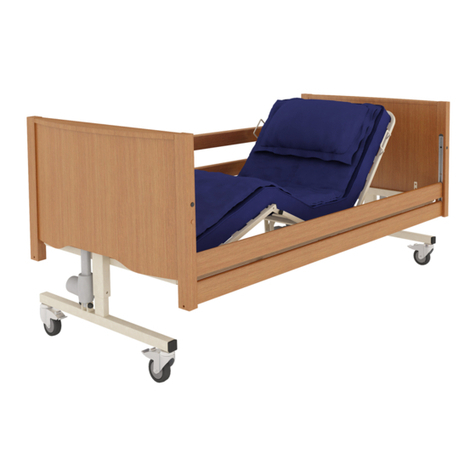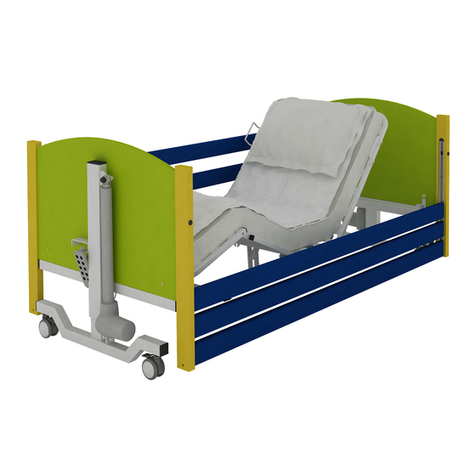3
CONTENTS
1. INTRODUCTION ....................................... 4
1.1. CONTACT........................................... 4
1.2. TO WHAT IT CONCERNS? ...................... 4
1.3. FEATURES.......................................... 4
1.4. USE .................................................. 5
1.5. CONTRAINDICATIONS........................... 6
2. WARNINGS AND CAUTIONS.................... 7
2.1. GENERAL WARNINGS ........................... 7
3. TRANSPORT AND STORAGE .................. 11
4. SYMBOL DEFINITIONS ........................... 13
5. PARTS .................................................... 15
5.1. PARTS SPECIFICATION ........................ 15
6. BED ASSEMBLY AND PREPARING FOR USE
................................................................... 16
6.1. FITTING ELECTRICAL SYSTEM................ 16
6.1.1. HOLDER ARRANGEMENTS ON
POWER CABLE................................................ 18
6.2. ASSEMBLING THE WOODEN BED ENDS .. 18
6.3. FITTING THE WOODEN,FULL-LENGTH SIDE
RAILS............................................................ 19
6.4. FITTING THE LIGHT SIDE RAILS ............. 20
6.5. FITTING THE SPLIT SIDE RAILS............... 20
6.6. CHECKING THE BED............................ 22
7. TRAINING............................................... 23
8. FIRST USE............................................... 24
8.1. OPERATIONAL LIMITS......................... 24
8.2. GENERAL SAFETY............................... 25
8.3. PREPARING FOR START....................... 25
8.4. BRAKE SYSTEM ................................. 26
8.4.1. CASTORS WITH INDIVIDUAL LOCK 27
8.4.2. AXEL LOCK OF THE CASTORS ...... 27
8.4.3. CENTRAL LOCK OF THE CASTORS . 27
8.5. SIDE RAILS AND MATTRESSES............... 27
8.5.1. SIDE RAIL SAFETY .....................28
8.5.2. MATTRESS THICKNESS ..............28
8.5.3. OPERATING THE WOODEN,FULL-
LENGTH SIDE RAILS..........................................29
8.5.4. OPERATING THE LIGHT SIDE RAILS
...................................................................29
8.5.5. OPERATING THE SPLIT SIDE RAILS 29
8.6. ELECTRICAL OPERATION......................30
8.6.1. HANDSET LOCATION.................31
8.6.2. 10 AND 9-BUTTON HANDSET
OPERATION....................................................32
8.6.3. HANDSET LOCKOUT..................33
8.7. LEG SECTION.....................................33
9. DISASSEMBLING THE BED FOR
TRANSPORT ...............................................35
10. POWER FAILURES ................................ 37
10.1. EMERGENCY LOWERING BACKREST AND
LEG SECTIONS.................................................37
11. DECONTAMINATION............................ 39
12. MAINTENANCE .................................... 41
12.1. GENERAL MAINTENANCE..................41
12.2. SERVICE LIFE...................................43
12.3. FAULTY FINDING..............................44
13. DISPOSAL OF PARTS ............................45
14. ELECTROMAGNETIC COMPATIBILITY
(EMC) .........................................................46
15. SPECIFICATION.....................................47
15.1. BED DATA ......................................47
15.2. MAXIMUM LOAD ............................47
15.3. TECHNICAL DATA OF SIDE RAILS..........48
15.4. ELECTRICAL DATA ............................49
16. ACCESSORIES ....................................... 50
16.1. MATTRESS AND SIDE RAILS ................51
17. LIFTING POLE .......................................53
18. WARRANTY ..........................................54
18.1. WARRANTY CONDITIONS ..................54

































